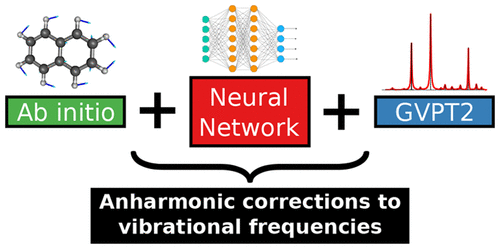当前位置:
X-MOL 学术
›
J. Chem. Theory Comput.
›
论文详情
Our official English website, www.x-mol.net, welcomes your
feedback! (Note: you will need to create a separate account there.)
Combining Quantum Mechanics and Machine-Learning Calculations for Anharmonic Corrections to Vibrational Frequencies.
Journal of Chemical Theory and Computation ( IF 5.7 ) Pub Date : 2020-01-31 , DOI: 10.1021/acs.jctc.9b00964 Julien Lam 1 , Saleh Abdul-Al 2 , Abdul-Rahman Allouche 3
Journal of Chemical Theory and Computation ( IF 5.7 ) Pub Date : 2020-01-31 , DOI: 10.1021/acs.jctc.9b00964 Julien Lam 1 , Saleh Abdul-Al 2 , Abdul-Rahman Allouche 3
Affiliation

|
Several methods are available to compute the anharmonicity in semirigid molecules. However, such methods are not yet routinely employed because of their high computational cost, especially for large molecules. The potential energy surface is required and generally approximated by a quartic force field potential based on ab initio calculation, thus limiting this approach to medium-sized molecules. We developed a new, fast, and accurate hybrid quantum mechanics/machine learning (QM/ML) approach to reduce the computational time for large systems. With this novel approach, we evaluated anharmonic frequencies of 37 molecules, thus covering a broad range of vibrational modes and chemical environments. The obtained fundamental frequencies reproduce results obtained using B2PLYP/def2tzvpp with a root-mean-square deviation (RMSD) of 21 cm-1 and experimental results with a RMSD of 23 cm-1. Along with this very good accuracy, the computational time with our hybrid QM/ML approach scales linearly with N, while the traditional full ab initio method scales as N2, where N is the number of atoms.
中文翻译:

将量子力学与机器学习计算相结合,以对振动频率进行非谐校正。
有几种方法可用于计算半刚性分子中的非谐性。但是,由于这些方法的计算成本高,特别是对于大分子,其尚未被常规使用。势能表面是必需的,并且通常基于从头算起通过四次力场势进行近似,因此将这种方法限制为中等大小的分子。我们开发了一种新的,快速且准确的混合量子力学/机器学习(QM / ML)方法,以减少大型系统的计算时间。通过这种新颖的方法,我们评估了37个分子的非谐频率,从而涵盖了广泛的振动模式和化学环境。所获得的基频再现了使用B2PLYP / def2tzvpp的均方根偏差(RMSD)为21 cm-1的结果和RMSD为23 cm-1的实验结果。除了具有非常好的准确性外,我们的混合QM / ML方法的计算时间与N呈线性比例关系,而传统的完全从头计算方法的比例为N2,其中N为原子数。
更新日期:2020-02-23
中文翻译:

将量子力学与机器学习计算相结合,以对振动频率进行非谐校正。
有几种方法可用于计算半刚性分子中的非谐性。但是,由于这些方法的计算成本高,特别是对于大分子,其尚未被常规使用。势能表面是必需的,并且通常基于从头算起通过四次力场势进行近似,因此将这种方法限制为中等大小的分子。我们开发了一种新的,快速且准确的混合量子力学/机器学习(QM / ML)方法,以减少大型系统的计算时间。通过这种新颖的方法,我们评估了37个分子的非谐频率,从而涵盖了广泛的振动模式和化学环境。所获得的基频再现了使用B2PLYP / def2tzvpp的均方根偏差(RMSD)为21 cm-1的结果和RMSD为23 cm-1的实验结果。除了具有非常好的准确性外,我们的混合QM / ML方法的计算时间与N呈线性比例关系,而传统的完全从头计算方法的比例为N2,其中N为原子数。











































 京公网安备 11010802027423号
京公网安备 11010802027423号